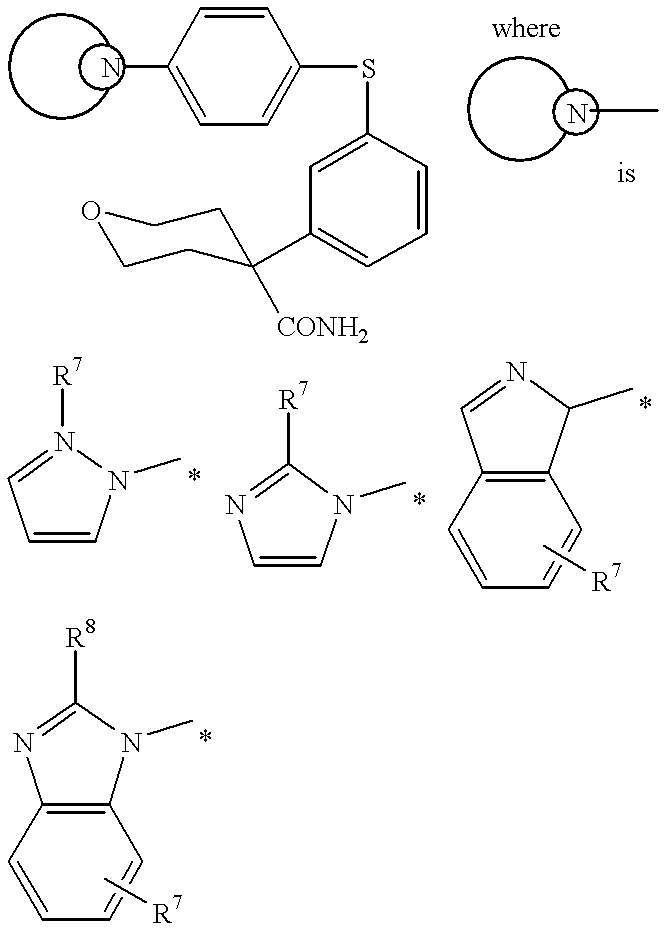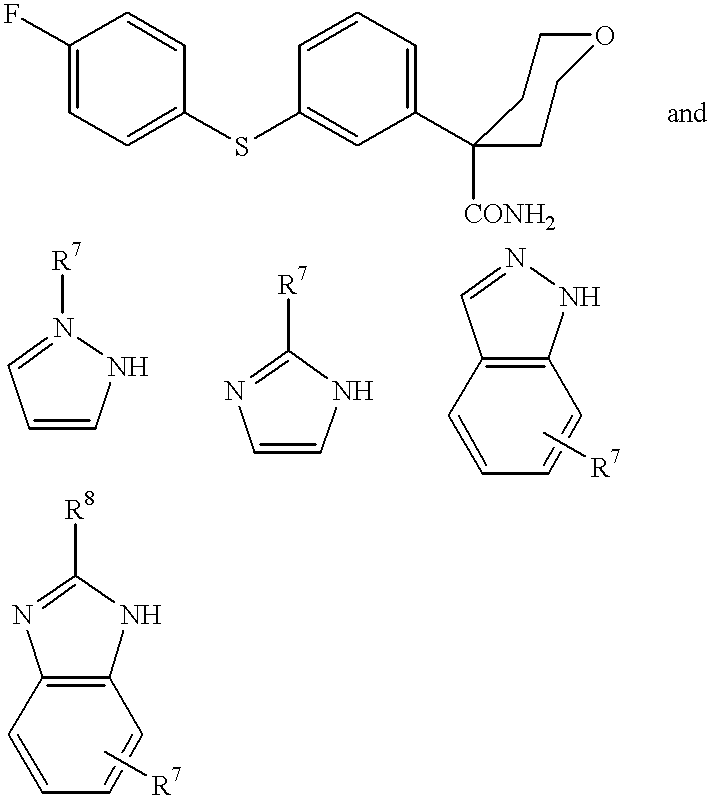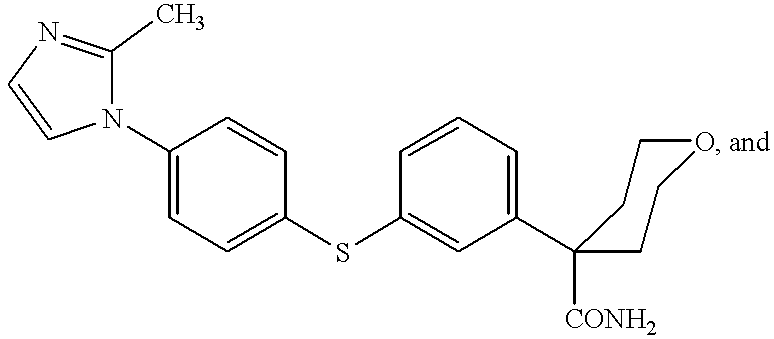Process for making 5-lipoxygenase inhibitors having varied heterocyclic ring systems
a technology of heterocyclic ring system and process, which is applied in the field of synthetic preparation of compounds, can solve the problems of low yield and products requiring further purification
- Summary
- Abstract
- Description
- Claims
- Application Information
AI Technical Summary
Problems solved by technology
Method used
Image
Examples
example 1
Synthesis of Tetrahydro-4-(3-bromophenyl)-2H-pyran-4-nitrile
##STR68##
3-Bromophenylacetonitrile (20.0 g, 102 mmole, 1 eq.), commercially available from Aldrich Chemical Co., Milwaukee, Wis., tetrahydrofuran (120 ml), 40% aqueous sodium hydroxide solution (180 ml, mmole, eq.), tetrabutylammonium hydrogensulfate (3.46 g, mmole, 0.1eq.) were stirred in a reaction flask set for boiling at reflux. Thereafter, 2,2'-dichlorodiethylether (13.75 ml, 117.3 mmole, 0.1eq.) was added with stirring at room temperature, 20-25.degree. C. The resultant reaction mixture was boiled at reflux for 5-8 h at approximately 64.degree. C. The reaction mixture was cooled to ambient temperature and ethyl acetate (154 ml) was added. The lower aqueous layer was separated and the organic layer evaporated down into a red oil. ISO sopropanol (100 ml) and water (10 ml) were added to the oil and stirred at 0.degree. C. overnight to yield a crystal slurry. The crystal slurry was vacuum filtered, washed with isopropanol...
example 2
Synthesis of Tetrahydro-4-[3-(4-fluorophenyl)-thio]-phenyl-2H-pyran-4-carboxamide
##STR69##
Propan-2-ol (311 ml), tetrahydro-4-(3-bromophenyl)-2H-pyran-4-nitrile (51.91 g, 0.195 mole, 1 eq.), potassium hydroxide (25.16 g, 0.39 mole, 2 eq.), water (4 ml, 0.39 mole, 2 eq.), tetrakis (triphenylphosphine)palladium(0) (2.26 g, 0.00195 mole, 0.01 eq.) and 4-fluorothiophenol (25 g, 0.195 mole, 1 eq.) were added to a reaction flask set for boiling at reflux under a nitrogen atmosphere. The resultant reaction mixture was boiled at reflux for 20-24 h at approximately 82.degree. C. The reaction mixture was cooled to ambient temperature, 20-25.degree. C. and water (315 ml) was added to obtain a slurry. The crude product was isolated by filtration and washed with 1:1 water: propan-2-ol (125 ml) and sucked dry. Crude dry product was dissolved in methanol (1900 ml), treated with activated charcoal, Darco KB-B (2.5 g) and Celite filter aid (10 g) at reflux temperature, approximately 60.degree. C., fo...
example 3
Synthesis of Tetrahydro-4-{3-[4-(2-methyl-1H-imidazol-1-yl)-phenyl ]-thio}-phenyl-2H-pyran-4-carboxamide Using Solid NaOH and Cs.sub.2 CO.sub.3
##STR70##
Tetrahydro-4-[3-(4-fluorophenyl)-thio]-phenyl-2H-pyran-4-carboxamide (25.0 g, 75.4 mmole, 1 eq), dimethylsulfoxide (250 ml, 10 vol), 2-methylimidazole (12.39 g, 150.9 mmole, 2.0 eq), sodium hydroxide (6.03 g, 150.9 mmole, 2.0 eq), and cesium carbonate (1.23 g, 0.38 mmole, 0.005 eq) were added to a reaction flask set for boiling at reflux under a nitrogen atmosphere, and the reaction mixture was heated at 125-130.degree. C. for 17-24 hours under nitrogen. After the reaction was completed, it was cooled (<30.degree. C.) and quenched with water (250 ml, 10 vol), which resulted in the formation of a precipitate. An exotherm of 10-15.degree. C. was observed during the water addition. The reaction slurry thus formed was cooled to room temperature (15-25.degree. C.) and then granulated for 1 hour. The product was isolated by vacuum filtrati...
PUM
| Property | Measurement | Unit |
|---|---|---|
| Angle | aaaaa | aaaaa |
| Angle | aaaaa | aaaaa |
| Angle | aaaaa | aaaaa |
Abstract
Description
Claims
Application Information
 Login to View More
Login to View More - R&D
- Intellectual Property
- Life Sciences
- Materials
- Tech Scout
- Unparalleled Data Quality
- Higher Quality Content
- 60% Fewer Hallucinations
Browse by: Latest US Patents, China's latest patents, Technical Efficacy Thesaurus, Application Domain, Technology Topic, Popular Technical Reports.
© 2025 PatSnap. All rights reserved.Legal|Privacy policy|Modern Slavery Act Transparency Statement|Sitemap|About US| Contact US: help@patsnap.com



